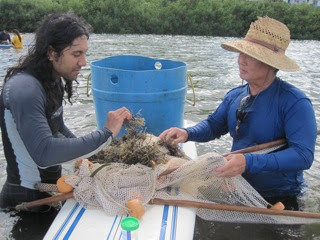
But we finally got to go to COCONUT ISLAND!! Whoo :) While at Coconut, we analyzed our data from the DO experiment we had just recently completed. First off, Sherril showed us some of the charts she made regarding algal cover in the fishpond.
 The charts we looked at were biomass vs % cover, % cover with bare sediment, and % cover without bare sediment. After discussing the meaning of the charts, it was time to input our own data!! First we had to come up with our parameters that was used in our experiment. Next we made graphs of our data.
The charts we looked at were biomass vs % cover, % cover with bare sediment, and % cover without bare sediment. After discussing the meaning of the charts, it was time to input our own data!! First we had to come up with our parameters that was used in our experiment. Next we made graphs of our data.

 We were all having slight difficulties with this part. Practically everyone (except Aukai) was not a Mac user. Becky, Jess, and Sam had a hard time converting some units for their data.
We were all having slight difficulties with this part. Practically everyone (except Aukai) was not a Mac user. Becky, Jess, and Sam had a hard time converting some units for their data.
After finally getting everything into the computers, we made some graphs to analyze our data. We looked at salinity, water velocity and DO. After spending most of the day in the classroom, we had some extra time to go swimming!! Everyone was so excited! That is until we actually got there. Since it was getting a little late (~530PM) it was kind of chilly. So only three people (Sam, Becky, and Daniel) actually went into the water. The rest of us just chilled and talked on shore.













































